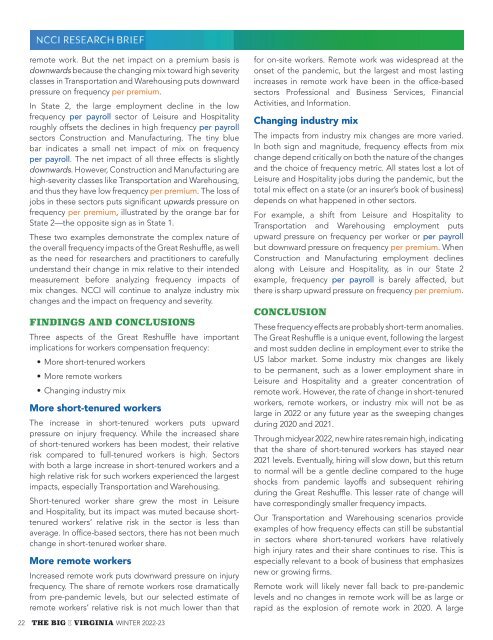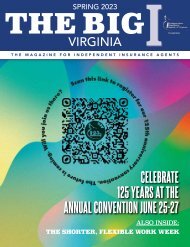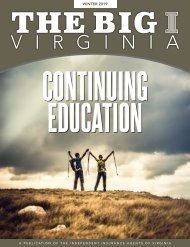The Big I Virginia Winter 2022-23
You also want an ePaper? Increase the reach of your titles
YUMPU automatically turns print PDFs into web optimized ePapers that Google loves.
emote work. But the net impact on a premium basis is for on-site workers. Remote work was widespread at the<br />
downwards<br />
Introduction<br />
because the changing mix toward high severity onset of the pandemic, but the largest and most lasting<br />
classes in Transportation and Warehousing puts downward increases in remote work have been in the office-based<br />
<strong>The</strong> Great Reshuffle is reshaping the US labor market. Unemployment is historically low, but labor force<br />
pressure on frequency per premium.<br />
sectors Professional and Business Services, Financial<br />
participation is still lower than the pre-pandemic rate. Labor<br />
In State 2, the large employment decline in the low Activities, shortages and Information. have led to wage growth, especially<br />
strong among low-wage workers and in sectors like Leisure and Hospitality.<br />
frequency per payroll sector of Leisure and Hospitality<br />
Changing industry mix<br />
roughly offsets the declines in high frequency per payroll<br />
Quit rates jumped in the middle of 2021 and remain high at the time of this writing—about 50 million quits a<br />
sectors Construction and Manufacturing. <strong>The</strong> tiny blue <strong>The</strong> impacts from industry mix changes are more varied.<br />
year, almost 10 million more than pre-pandemic averages.<br />
bar indicates a small net impact of mix on frequency In both Many sign workers and magnitude, are new to frequency their jobs. effects Some from of these mix<br />
per are payroll. moving <strong>The</strong> from net impact one similar of all job three to another, effects is but slightly others change are changing depend industries critically on or both occupations. the nature At of the changes same<br />
downwards. time, there However, are a large Construction number and of new Manufacturing remote workers. are and Many the people choice of left frequency the office metric. at COVID’s All states onset; lost there a lot of has<br />
high-severity been a trickle classes back, like representing Transportation a and massive Warehousing, change in the Leisure amount and of Hospitality remote work jobs during compared the pandemic, to before but the the<br />
and thus they have low frequency per premium. <strong>The</strong> loss of total mix effect on a state (or an insurer’s book of business)<br />
pandemic.<br />
jobs in these sectors puts significant upwards pressure on depends on what happened in other sectors.<br />
frequency How do per such premium, large changes illustrated in the by the labor orange market bar impact for For workers example, compensation a shift from injury Leisure frequency? and Hospitality <strong>The</strong> magnitude to<br />
State of 2—the these impacts opposite relies sign as on in the State interaction 1. of three factors: Transportation and Warehousing employment puts<br />
<strong>The</strong>se two examples demonstrate the complex nature of upward pressure on frequency per worker or per payroll<br />
the overall • frequency How much impacts more of or the less Great likely Reshuffle, are short-tenured as well but or downward remote workers pressure to on be frequency injured than per premium. other workers? When<br />
as the need • How for researchers much has the and share practitioners of such to workers carefully changed? Construction and Manufacturing employment declines<br />
understand • How their has change the in sector mix relative mix of the to their workforce intended changed along during with the Leisure pandemic?<br />
Hospitality, as in our State 2<br />
measurement before analyzing frequency impacts of example, frequency per payroll is barely affected, but<br />
mix changes. NCCI will continue to analyze industry mix there is sharp upward pressure on frequency per premium.<br />
changes and the impact on frequency and severity.<br />
CONCLUSION<br />
FINDINGS AND CONCLUSIONS<br />
<strong>The</strong>se frequency effects are probably short-term anomalies.<br />
Three aspects of the Great Reshuffle have important <strong>The</strong> Great Reshuffle is a unique event, following the largest<br />
implications for workers compensation frequency:<br />
and most sudden decline in employment ever to strike the<br />
• More short-tenured workers<br />
US labor market. Some industry mix changes are likely<br />
to be permanent, such as a lower employment share in<br />
• More remote workers<br />
Leisure and Hospitality and a greater concentration of<br />
• Changing industry mix<br />
remote work. However, the rate of change in short-tenured<br />
workers, remote workers, or industry mix will not be as<br />
large in <strong>2022</strong> or any future year as the sweeping changes<br />
during 2020 and 2021.<br />
More short-tenured workers<br />
<strong>The</strong> increase in short-tenured workers puts upward<br />
pressure on injury frequency. While the increased share<br />
of short-tenured workers has been modest, their relative<br />
risk compared to full-tenured workers is high. Sectors<br />
with both a large increase in short-tenured workers and a<br />
high relative risk for such workers experienced the largest<br />
impacts, especially Transportation and Warehousing.<br />
Short-tenured worker share grew the most in Leisure<br />
and Hospitality, but its impact was muted because shorttenured<br />
workers’ relative risk in the sector is less than<br />
average. In office-based sectors, there has not been much<br />
change in short-tenured worker share.<br />
More remote workers<br />
Increased remote work puts downward pressure on injury<br />
frequency. <strong>The</strong> share of remote workers rose dramatically<br />
from pre-pandemic levels, but our selected estimate of<br />
remote workers’ relative risk is not much lower than that<br />
22 THE BIG I VIRGINIA WINTER <strong>2022</strong>-<strong>23</strong><br />
Through midyear <strong>2022</strong>, new hire rates remain high, indicating<br />
that the share of short-tenured workers has stayed near<br />
2021 levels. Eventually, hiring will slow down, but this return<br />
to normal will be a gentle decline compared to the huge<br />
shocks from pandemic layoffs and subsequent rehiring<br />
during the Great Reshuffle. This lesser rate of change will<br />
have correspondingly smaller frequency impacts.<br />
Our Transportation and Warehousing scenarios provide<br />
examples of how frequency effects can still be substantial<br />
in sectors where short-tenured workers have relatively<br />
high injury rates and their share continues to rise. This is<br />
especially relevant to a book of business that emphasizes<br />
new or growing firms.<br />
Remote work will likely never fall back to pre-pandemic<br />
levels and no changes in remote work will be as large or<br />
rapid as the explosion of remote work in 2020. A large

















